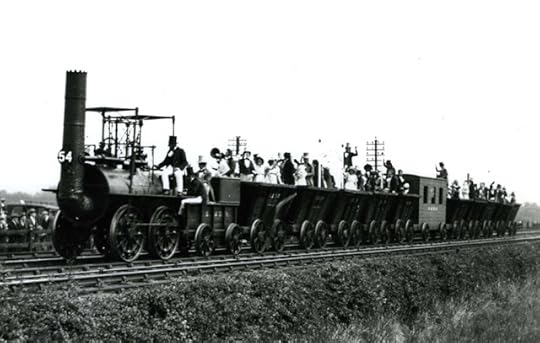Clancy Tucker's Blog, page 30
January 1, 2022
22 February 2022 - GREAT SACRIFICE DURING THE PLAGUE
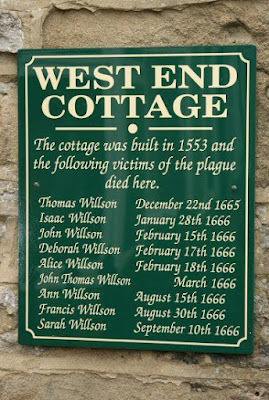
GREAT SACRIFICE
DURING THE PLAGUE
G'day folks,
This story is relevant to our current times.
After the Great Plague of London broke out in 1665, 100,000 people (almost a quarter of the population) were dead within seven months. Those who could afford it fled the capital to escape the pestilence. But distance was no protection, as villagers 160 miles away in Eyam, Derbyshire, were to discover.
When George Viccars, the village tailor, took delivery of a bale of cloth from London, he found it to be damp and hung it out to dry by a fire. He had no idea that by doing so he was introducing death into the community.
Viccars was unaware that fleas from rats caused the plague and that his cloth was infested with them. Within a week he was dead. By the end of the month five other villagers had died and another 23 fell victim in the following month.
And then a legend was created. After fatalities mounted, the church leader, William Mompesson, who was born on this day, 28th April, in 1639, took the courageous decision to isolate the village from the outside world, thus preventing the spread of the disease.
Some of the villagers wanted to flee, but Mompesson, working with another clergyman, Thomas Stanley, was the driving force in persuading them to stay. The quarantine was a momentous decision by the villagers who knew that they might well be giving their own lives to save others.
Grateful outsiders brought money, which was left in a water trough containing vinegar to sterilise the coins, and food, which was left it at the boundary of the village. Thus the villagers were not left to starve.
When the plague had finally taken its toll by November 1666, 260 people, out of Eyam’s population of 350, were dead. They included Mompesson’s wife, Caroline.
Their sacrifice may well have saved many thousands of lives in the North of England and the historic episode is still commemorated each year in the village.

Clancy's comment: Day by day, I wonder what will happen to us in this world pandemic.
I'm ...


December 31, 2021
25 February 2022 - 'BEAUTIFUL BETSY' CRASH SITE - AUSTRALIA

'BEAUTIFUL BETSY'
CRASH SITE - AUSTRALIA
G'day folks,
For nearly 50 years this airplane that crashed during World War II remained missing in the remote Australian bush.On February 26, 1945, a B-24 Liberator bomber named the Beautiful Betsy went missing on a flight across Australia from Darwin to Brisbane. Onboard were six Americans and two British soldiers. The bomber, which had been damaged in previous combat missions, was now only used for short transportation flights and was slated to be retired once it could be replaced. The reason for the Beautiful Betsy’s crash remains unknown, but both mechanical failure and stormy weather could have been factors.


Several expeditions were dispatched to find the bomber but none were successful and over the decades the missing plane became a largely forgotten mystery. Or it was, until August of 1994, when a park ranger journeyed to a remote section of the Kroombit Tops National Park to survey the effects of a prescribed fire. The fire had cleared the overgrowth of vegetation and the ranger saw something metallic glinting in the sun.
Initially the location of the discovery was kept secret to discourage souvenir hunters and prevent people from trampling over the site until it could be fully studied. The U.S. Army sent over specialists to sift through the crash for artifacts and human remains. Once they were done the site, including the remaining pieces of the Beautiful Betsy, were opened to visitors of the national park. Today trails lead to the debris and signs tell the story of the missing bomber.

Clancy's comment: An important find.
I'm ...


December 29, 2021
16 February 2022 - DOROTHY'S GRAVE

DOROTHY'S GRAVE
G'day folks,
The carved remains of a 200-year-old oak tree memorialize the namesake of the iconic "Wizard of Oz" character.Two of 20th-century literature’s most iconic characters guard this humble gravestone. They honor not just the story, but the young child who inspired Dorothy’s name.
Author L. Frank Baum named the lead character in his book The Wonderful Wizard of Oz after his niece, Dorothy Louise Gage. His reason for doing so is perhaps more somber than you might think.
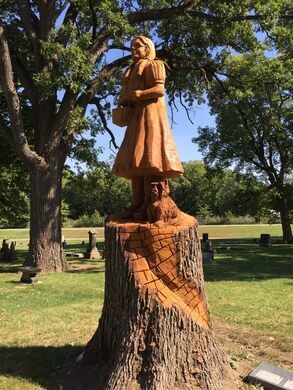
Tragically, only five months after her birth in 1898, the young girl died from a pneumonia-like illness called “congestion of the brain.” She was buried in Evergreen Memorial Cemetery in Bloomington, Illinois. To comfort the family, Baum bestowed the name Dorothy upon his fictional heroine.
In 2018, an oak tree adjacent to Gage’s small grave died. Rather than have it cut down, the cemetery hired a tree carver to sculpt into the oak’s remains a likeness of Baum’s Dorothy alongside Toto and the Yellow Brick Road.
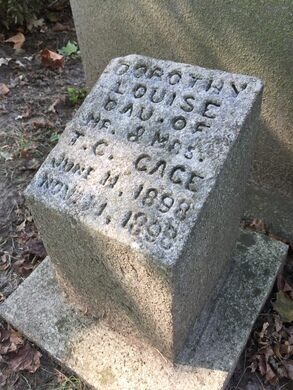 Clancy's comment: I've seen heaps of trees carved by craftsmen, using chainsaws. Very clever. I'm ...
Clancy's comment: I've seen heaps of trees carved by craftsmen, using chainsaws. Very clever. I'm ...
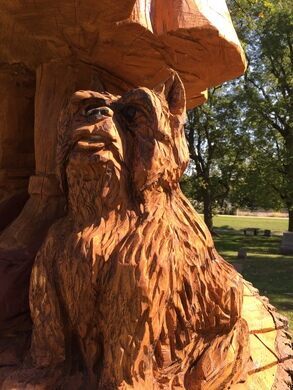
December 27, 2021
14 February 2022 - 'LA LECON' - THE LESSON
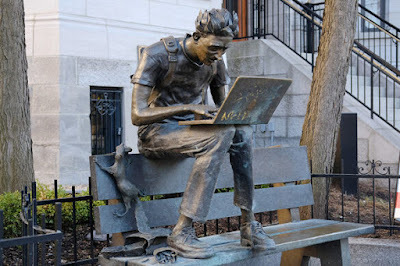
'LA LECON'
- THE LESSON -
G'day folks,
Immortalized in bronze, this frazzled student will be glued to his screen for centuries.It’s hard to use a keyboard in a blizzard. But even on the grisliest of winter days, there’s always at least one student lost in a laptop near the grand entrance gates of McGill University in Montreal.
With a fruit-branded notebook, fast food strewn at his feet, and one shoelace undone, the bronze sculpture titled “La Leçon” (“The Lesson”) is a heavy-handed lampoon of student life. It’s the creation of artist Cédric Loth, who has also worked as a creative director and cartoonist. The sculpture is littered with little jokes, from the laptop’s pear-shaped logo (in French, “poire” means “a gullible person”) to the squirrel swiping a hamburger bun. The distressed student’s slick haircut seems to droop in despair. As if his day couldn’t get any worse, his browser window bears the news “Steve Jobs est mort” (Steve Jobs is dead)!
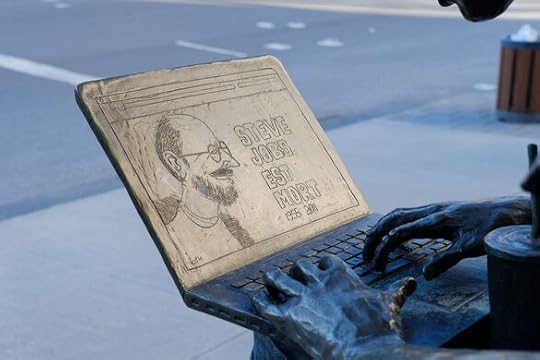
Placing such a crass caricature across from the entrance of one of Canada’s most prestigious universities might be seen as a prank. Indeed, since its unveiling in 2012, the statue has occasionally been counterattacked by vandals. Someone tried to saw off one of its fingers, and his browser window was once replaced by an error message warning “too much time on social media!”

With its tiny trackpad and generous array of ports, the student’s laptop already seems a little dated. You have to wonder how this disheveled bronze buffoon will be seen a hundred years from now, when he could very well still be failing upwards at the corner of Sherbrooke and McGill College Avenue.
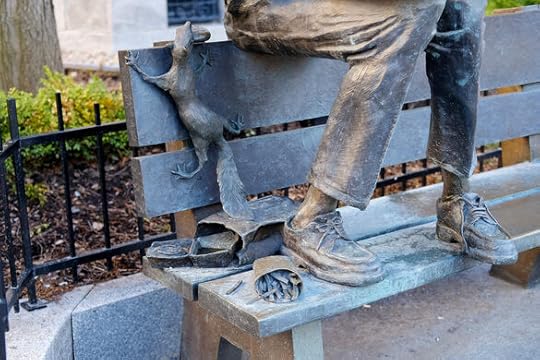
Clancy's comment: These statues always enchant me. As you will see below, here are some I've photographed in SE Asia.
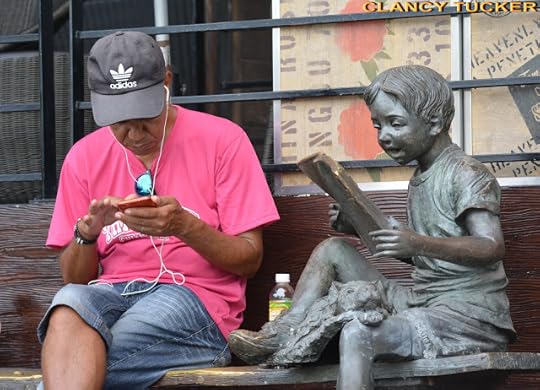
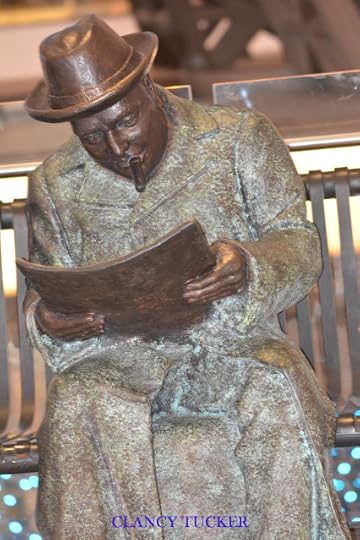
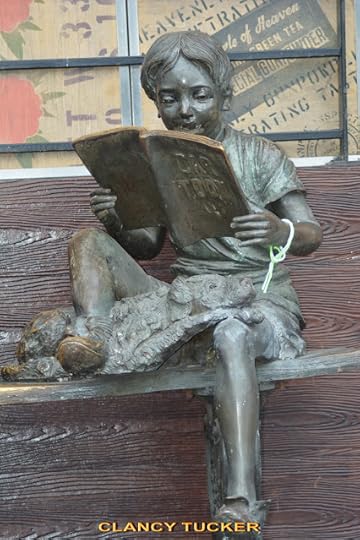
I'm ...
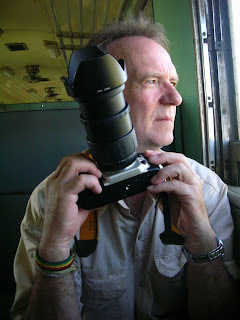
13 February 2022 - BAMBOO WALKWAY FOR BUDDHIST MONKS - THAILAND

BAMBOO WALKWAY
FOR BUDDHIST MONKS
- THAILAND -
G'day folks,
This serene bamboo walkway allows Buddhist monks from remote temples to access a nearby village.After the thrill of hiking Pai Canyon or visiting the nearby Pam Bok waterfall, head over to this tranquil bamboo walkway to recharge, restore, and clear the mind. Handcrafted by local villagers in the Mae Hong Son province, Boon Ko Ku So Bridge stretches over lush rice paddies and makes for one of the most picturesque mountain views in the region.





With its opulent forest scenery with lush vegetation, Boon Ko Ku So Bridge is not only Insta-worthy, but it’s perfect for a meditative nature walk. The pliable bamboo bridge has a lively buoyancy to it as you walk along the handmade, 800-meter stretch.
If you arrive before 8 a.m., you can also catch a glimpse of the early morning alms giving from local villagers to the Buddhist monks. When the villagers give alms to the monks, they bring a variety of small dishes, including individual portions of spicy chicken curry and vegetables, white rice, and a local dessert all wrapped and steamed inside the sacred pandan leaf. In the early morning hours, the area isn’t tourist-heavy, so you’re sure to get some nature time for yourself and find your own zen, too.
There’s a small temple on the bridge, as well as a flower swing for a photo opp with a backdrop of the mountains. There’s also a coffee shop right on the bridge, which artfully prepares its locally sourced beans.

Clancy's comment: Great to see, but even better to photograph.
I'm ...


December 26, 2021
18 February 2022 - OSLER LIBRARY - THE HISTORY of MEDICINE

OSLER LIBRARY
- THE HISTORY of MEDICINE -
G'day folks,
One of the world's largest collections of rare medical texts and ephemera.This library began as the personal collection of one of McGill University’s most famous graduates: Sir William Osler. After his death in 1919, it was bequeathed to McGill. The library and its fittings were disassembled in Oxford, England and shipped to Montreal. After moving several times over the years, it was reconstructed within the modern biomedical library.

Now one of the largest and most valuable collections of rare medical books and ephemera in the world, to step into the Osler Library is to enter the study of a late-Victorian gentleman scholar. Osler’s desk, bookcases, reading tables and other furnishings are all around you. It is a startling contrast to the modern biomedical library around it, rather like stepping into a literary Tardis.
If you visit, say hello to Sir William, his ashes are held in his library!

Clancy's comment: An amazing wealth of knowledge.
I'm ...


December 25, 2021
9 February 2022 - FIRST U.S. PRESIDENT TO RESIGN - RICHARD NIXON
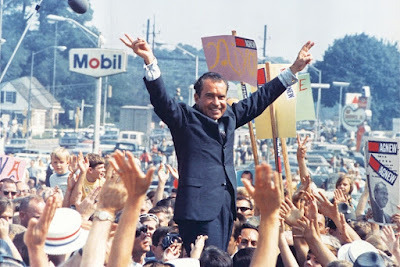
FIRST U.S.
PRESIDENT TO RESIGN
- RICHARD NIXON -
G'day folks,
Richard Nixon will always be remembered for the Watergate scandal, and for being the only US President ever to resign from office.
Both events overshadowed his achievements, which in foreign affairs included ending the war against Vietnam, establishing diplomatic relations with China, and setting up the Anti-Ballistic Missile Treaty with Russia.
At home he ended the military draft, enforced desegregation of schools in the southern states, established the Environmental Protection Agency, and signed the National Cancer Act, which set up the ongoing “war on cancer”.
It all seemed like a presidency of which he could be proud and in 1972 he was re-elected for a second term in one of the largest electoral landslides in American history. He won more than 60 percent of the popular vote, taking every state in the union except for two – Massachusetts and the District of Columbia. Then came the Watergate revelations . . .
Richard Milhous Nixon was born in 1913 to a poor farming family in California. He achieved excellent grades at school but had to turn down a scholarship from Harvard because his family could not afford to send him there by train.
He went on to graduate from law school in 1937 and then began to practise law.
He saw active duty in the Navy during the Second World War and was elected to the House of Representatives as a Republican in 1946. In 1950 he was elected to the Senate and was chosen as Dwight D. Eisenhower’s running mate in the 1952 presidential election.
After serving for eight years as Vice-President he ran for the top job himself in 1960 but was narrowly defeated by the charismatic John F. Kennedy. Nixon’s chance came again in 1968, a tumultuous year which saw President Lyndon B. Johnson withdraw from the presidential race, the assassination of both Martin Luther King and Bobby Kennedy, and widespread anti-Vietnam war riots across the country.
Nixon defeated both the Democrat Hubert Humphrey and Alabama governor George Wallace who represented the American Independent Party, campaigning for racial segregation. (Wallace won five states in the Deep South).
As Nixon’s first term of office was coming to a close, the White House became focused on re-election. And on June 17, 1972, five men broke into the Democratic National Committee's headquarters at the Watergate office complex in Washington DC where they were caught wiretapping phones and stealing documents.
One of them was James W. McCord, the security chief of the Committee to Re-elect the President. His arrest was reported in the next morning’s Washington Post by two young reporters, Carl Bernstein and Bob Woodward.
Dismissing the story as inconsequential, Nixon’s Press Secretary, Ron Ziegler, said at a routine White House Press conference that the President would have no comment on a “third-rate burglary attempt.”
Bernstein and Woodward, though, began to be fed information by an anonymous source whom they referred to as “Deep Throat.” His identity would be kept secret for over 30 years until in 2005 William Mark Felt, who at the time of the scandal was associate director of the FBI – the bureau’s second-highest ranking post – revealed himself to be the source.
With Felt’s guidance Woodward and Bernstein produced one explosive story after another. They revealed the direct involvement in Watergate of Nixon’s close associates and that the break-in and wiretapping had been financed by illegally laundered campaign contributions.
Then on October 10 came a sensational front-page article revealing that the Watergate break-in “stemmed from a massive campaign of political spying and sabotage conducted on behalf of President Nixon’s re-election and directed by officials of the White House.”
Rumors and revelations continued almost daily until on February 7, 1973, the Senate Watergate Committee was set up to investigate the scandal.
Richard Nixon was an insecure man handicapped by a persecution complex, and in February 1971, he had arranged for a secret voice-activated bugging system using telephone taps and concealed microphones to be installed in the White House, including the Oval Office.
Its existence was revealed in July, 1973 during testimony to the Senate committee by White House aide Alexander Butterfield. It later emerged that up to that point Nixon had tape-recorded 3,700 hours of conversations. His rejection of a congressional subpoena to release the tapes constituted an article of impeachment that led to his downfall.
Under enormous pressure, the White House released some subpoenaed tapes on August 5. One of them, later known as the "smoking gun" tape, revealed the initial stages of the Watergate cover-up, with Nixon and his chief of staff, H.R. (Bob) Haldeman, discussing how to block investigations. It demonstrated that the President knew of the Watergate break-in shortly after it took place and that he had approved plans to thwart official scrutiny.
Facing certain impeachment in the House of Representatives and equally certain conviction in the Senate, Nixon announced his resignation on the evening of August 8, 1974.
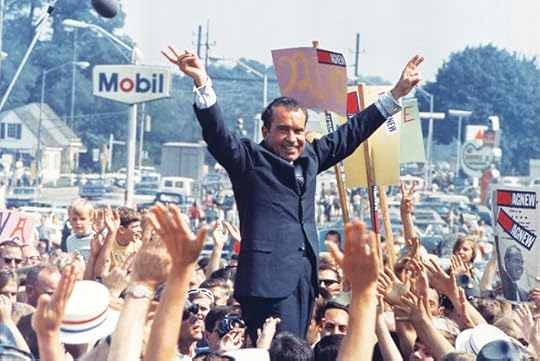
In a televised broadcast he said: “I have never been a quitter. To leave office before my term is completed is opposed to every instinct in my body. But as President I must put the interests of America first. Therefore, I shall resign the presidency effective at noon tomorrow.”
Gerald Ford, the Vice-President, immediately took charge and a month later granted Nixon "a full, free, and absolute pardon” for all crimes associated with Watergate.
Richard Nixon died after a stroke on April 22, 1994, aged 81. World leaders attended his funeral, as did every living President. In his eulogy, Bill Clinton praised Nixon's accomplishments, particularly in foreign affairs, and pleaded: "May the day of judging President Nixon on anything less than his entire life and career come to a close.”
Interviewed by David Frost in 1977, the man himself reflected: “I gave 'em a sword. And they stuck it in, and they twisted it with relish. And I guess if I had been in their position, I'd have done the same thing.”
A few years later he gave a more considered view of his resignation: “I think the best description of how I felt then was a little poem that read,
‘I am hurt, but I am not slain.
I shall lay me down and bleed a while
And I shall rise and fight again.’
“That’s the story of my life,” he commented with a wry grin.
Nixon fought for the rest of his days to prevent the release of his recorded conversations. The Government began releasing the secret tapes after his death, the final tape being made public in 2013.
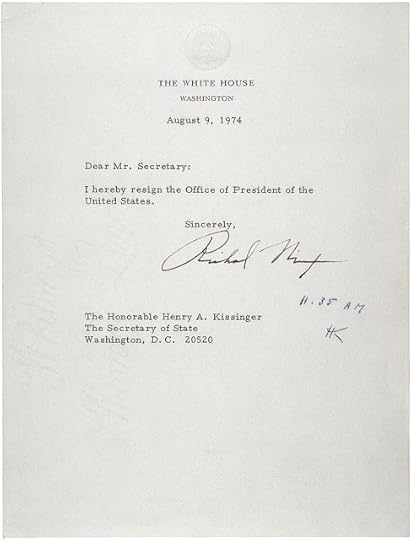
Clancy's comment: I worked in Washington DC during these wild times, and maybe should write a book about it.
I'm ...


December 22, 2021
17 February 2022 - THE RED PHONE BOX LIBRARY

THE RED PHONE
BOX LIBRARY
G'day folks,
A classic red phone box has been converted into an informal village library.Though classic red phone boxes of the United Kingdom have largely fallen out of use in modern times, one village has given the local payphone new life. After the phone was removed from this box, the residents of Millbourne in Wiltshire turned it into a library. Donated books fill the miniature library at the old red phone box on Milbourne Lane. Other villagers can borrow and return the books on an informal basis.


If you wish to support the enterprise and donate to the village library, or simply wish to see a quaint new twist on the classic red phone box, this is the place to come. The village is also a suitable jumping off point to explore the countryside or the nearby town of Malmesbury.
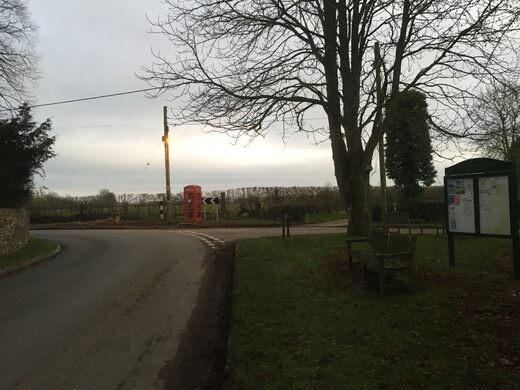 Clancy's comment: What a great idea.
Clancy's comment: What a great idea.I'm ...


10 February 2022 - COLIN'S 'TOLKIEN' BARN - ENGLAND
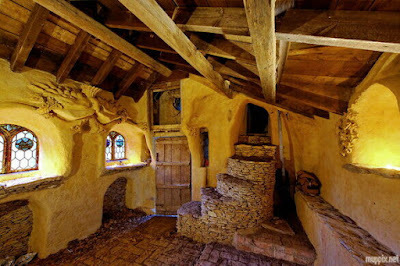
COLIN'S 'TOLKIEN' BARN
- ENGLAND -
G'day folks,
Colin Stokes "got a bit carried away" and built a castle that looks like something out of Tolkien.Colin Stokes just wanted to build a barn to store hay and house his sheep. Then he “got a bit carried away,” and ended up with a castle that looks like something out of The Lord of the Rings.
The Hobbit House, also known as Colin’s Barn, in Chedglow, England, has been abandoned since Stokes moved away in 2000 to avoid the noise of a forest marble quarry opening up nearby. He never finished his project, which he had started 1989 using rocks and stones from around his property, and concrete to hold them together.
Inspired by buildings he had seen over the years, Stokes started with a simple rectangular structure, put up with dry-stone techniques. Then he just kept going. He added turrets and dovecotes, stained glass windows featuring the seasons and the elements (which Stokes made himself), a spiral staircase, and beautiful arches. All of it was done by hand, and with no plans drawn up in advance.

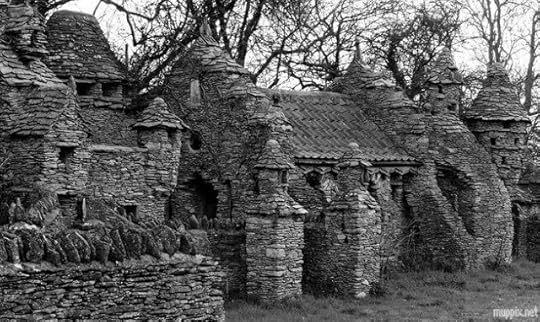
Several birds, including an owl, lived in the turrets and dovecotes while Stokes was building, and those parts are now dominated by birds. On the second floor, Stokes added a room for himself so he could live in the structure during lambing season, though he mostly lived in a nearby cottage.
Built to blend into its surroundings, the building has come to be known as the “Hobbit House,” though Stokes takes issue with the nickname. He thought of it simply as his barn. To be fair, unlike a hobbit’s home, the structure is not built into the side of a hill. But it does look a bit like a hill itself. The barn is a little difficult to find, and is on private land. A sign discourages visitors, but it doesn’t seem to work. The structure is still in very good condition—a testament to the builder’s skill.
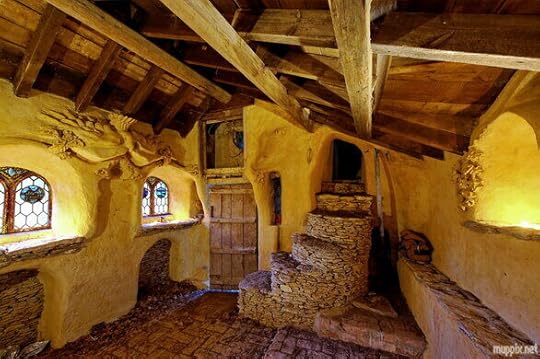
Clancy's comment: Wow, how cool is that?
I'm ...


December 20, 2021
15 February 2022 - FIRST PASSENGER TRAIN REACHES 15 MPH
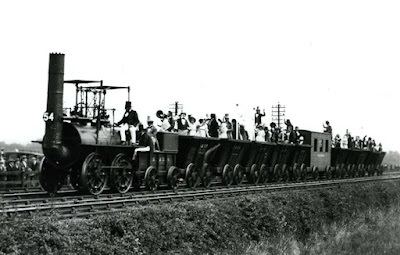
FIRST PASSENGER TRAIN
REACHES 15 MPH
G'day folks,
For the first time in history a steam locomotive carried passengers on a public railway in 1825. The engine was called Locomotion No. 1 and in control was its designer, the engineer George Stephenson.
It belonged to the Stockton and Darlington Railway, which operated across the North East of England. Apart from 36 wagons filled with sacks of coal and flour, the train included a purpose-built passenger coach called The Experiment. Bone-shaking and springless, the carriage resembled a shed on wheels and was occupied by various dignitaries.
The rest of the passengers stood in open coal wagons, though a few had the "luxury" of temporary wooden benches.
The directors had allowed room for 300 passengers, but the train left carrying between 450 and 600 people, some travelling on top of wagons full of coal.
As the train set off, watched by hundreds of curious onlookers, it was led by a man on horseback with a flag and managed to cover eight and a half miles (14km) in two hours at an average speed of 8mph (13km/h).
The historic journey came about after a meeting between Stephenson, who had built steam engines to work in local collieries, and Edward Pease, the son of a wool merchant.
Pease rode round the country buying fleeces from farmers and in the course of his travels became convinced of the need for a railroad to carry coal from the collieries to an East Coast port. In 1821, with a group of businessmen, he formed the Stockton & Darlington Railway company.
Then he came up with a plan for an eight-mile (12.9km) line to exploit a rich vein of coal. The coal wagons would be pulled by horses.
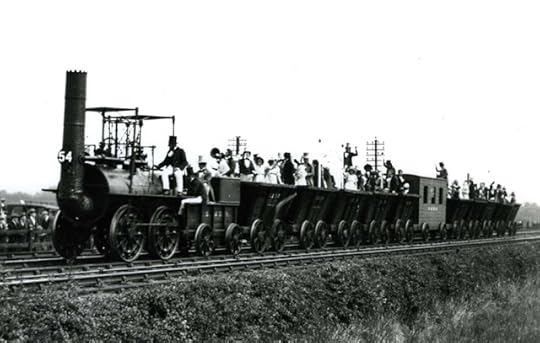
When he heard of the scheme, Stephenson contacted Pease and told him that he should consider building a locomotive railway and that he had already built a locomotive that was "worth fifty horses".
Pease saw the engine at work, realised Stephenson was right and offered him the post of chief engineer at the railroad company.
So it was that the historic "passenger train" made its first run. But it was not the only railway "first": it was also the scene of the first recorded accident involving a passenger. When the horseman ahead of the train was out of the way and the train was going down a slope, Stephenson opened the throttle and his train reached the staggering speed of 15mph (24km/h).
This so unnerved one passenger that he fell off and his foot was crushed by the following wagon.

Clancy's comment: Well, there ya go. Now, we have trains doing amazing speeds.
I'm ...

